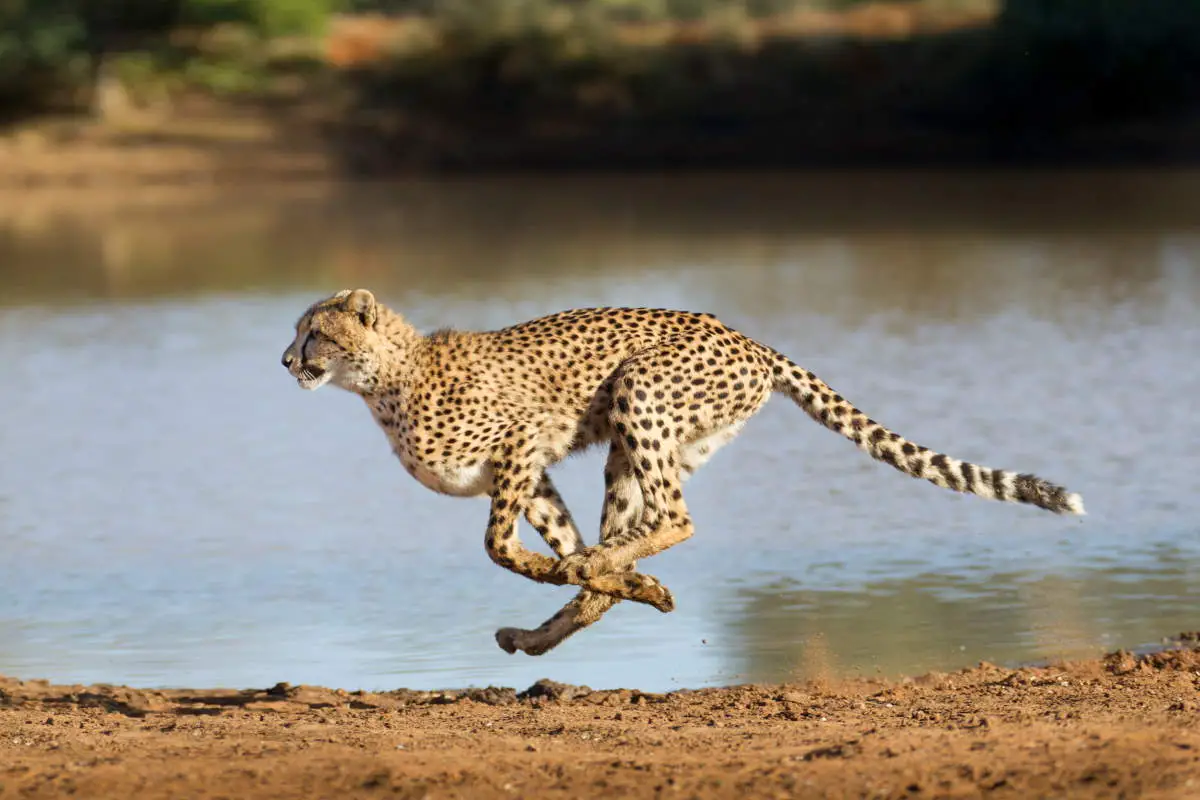The cheetah (scientific name: Acinonyx jubatus) is a large cat of the subfamily Felinae, which specialized for high speed. Cheetahs live in North and East Africa, and a few localities in Iran. Here are 20 amazing cheetah facts.
1. Cheetah is the fastest land animal on Earth
The cheetah is the fastest land animal on Earth. Its body is specialized for speed.
They have a thin, aerodynamic frame with a narrow waist and a deep chest. Their extra-large nostrils allow for increased oxygen intake, with larger than-normal hearts and lungs and strong arteries and adrenals that work in tandem to circulate oxygen more efficiently. They also have extremely light bones.
Vertical shoulder blades, which are not attached to the cheetah’s small collarbone, as well as hips that swivel on a flexible spine help lengthen the cheetah’s stride and provide superior acceleration. The cheetah’s spine works as a spring for its powerful back legs, extending its reach with each step.
Their inner ear also helps them to keep their balance at high speeds. According to a 2018 study, “the inner ear facilitates the cheetah’s remarkable ability to maintain visual and postural stability while running and capturing prey at speeds of up to 65 miles per hour.”
“If you watch a cheetah run in slow motion, you’ll see incredible feats of movement: its legs, its back, its muscles all move with such coordinated power. But its head hardly moves at all,” says lead author Camille Grohé.
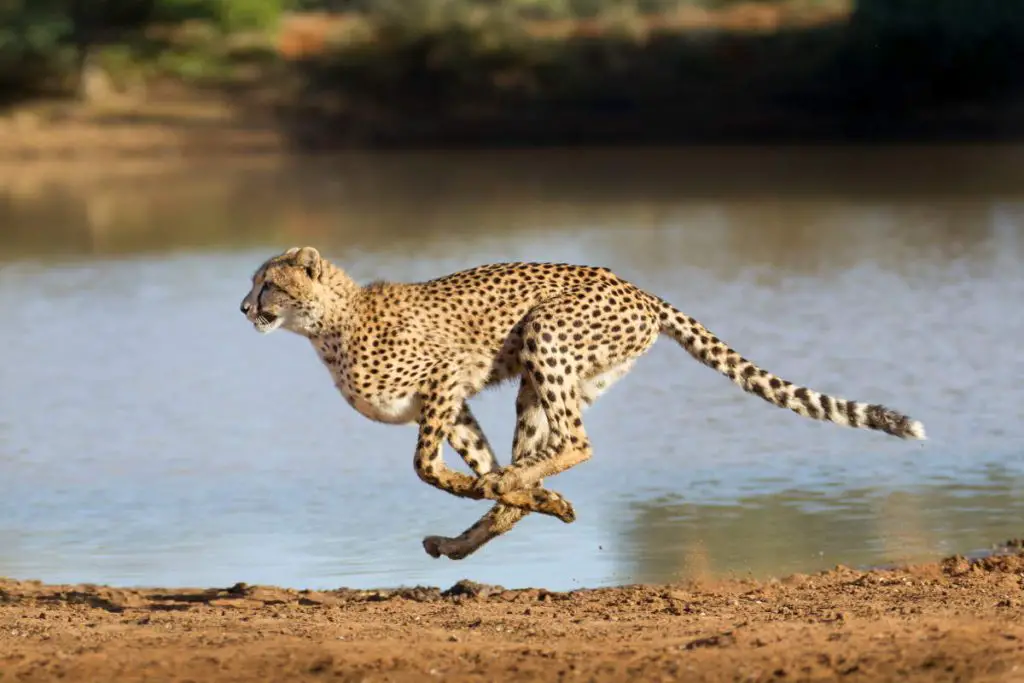
What is the top speed of the cheetah?
Different sources cite different top speeds for a cheetah; estimates include 96-120 km/h (60-75 mph). But the fastest properly authenticated cheetah was a female South African cheetah (Acinonyx jubatus
She was known as the world’s fastest land mammal according to National Geographic magazine. Sarah ran 100 meters in 5.95 seconds in 2012 when she was 11 years old and was radar-timed at up to 61 mph (98.1 km/h). She died (put to sleep because of her diminished quality of life) on 22 January 2016 at the age of 15.
11 years is quite old for a feline, it is the equivalent of approximately 60 human years. Maybe she was even faster when she was younger? Unfortunately, we’ll never know. But, I believe there are faster cheetahs out there in the wild.
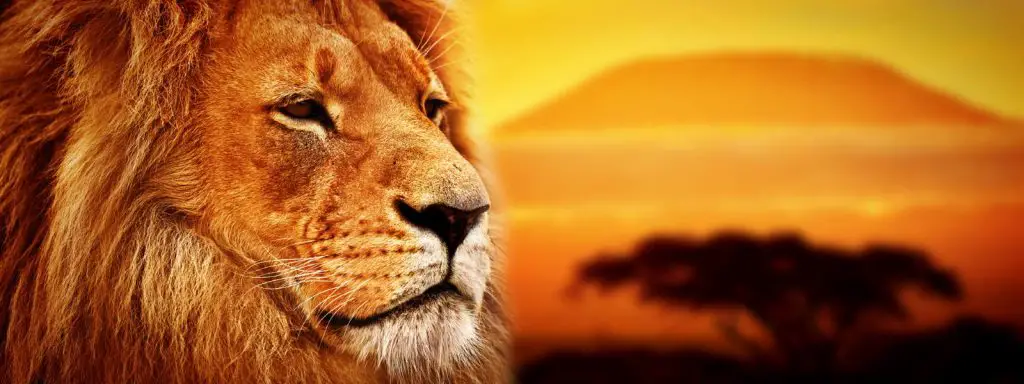
Related: 20 amazing lion facts
2. Cheetahs use their tail for balance during a chase
Cheetahs have a long, muscular tail that has flat shape. The tail almost functions like a rudder on a boat because they use it to help control their steering, counter angular momentum, and keep their balance when running very fast.
3. They are big cats
Cheetahs can reach 70 to 90 cm (28 to 35 in) at the shoulder and weigh 21-66 kg (46-145 lb), making them about the same weight as a leopard. Although taller than the leopard, the cheetah has a lighter build. But, a cheetah is much smaller than a lion.
The head-and-body length ranges from 112-150 cm (44-59 in).
Males are slightly bigger with larger heads, but there is not much physical difference between the sexes. It is difficult to identify the cheetah’s sex by appearance alone.
4. Cheetahs purr!
Like a house cat, the cheetah purrs when content, or to greet known individuals. It can purr while both inhaling and exhaling, which other big cats cannot.
5. Cheetahs don’t roar
Unlike other big cats often grouped with the cheetah (i.e.- tiger, lion, leopard, and jaguar), cheetahs do not roar. They growl when facing danger, and they vocalize with sounds more equivalent to a high-pitched chirp or bubble and bark when communicating with each other.
6. They have semi-non-retractable claws
Unlike other cats, cheetahs’ claws are not retractable, they are semi-non-retractable instead. Their claws work like the cleats on a football shoe to give the cheetah a lot of traction when running.
Furthermore, while the pads of most cats’ paws are soft, the cheetah’s pads are hard, kind of like the rubber on a tire. So, their feet closely resemble that of a dog. These features offer better traction to get to those high speeds.
7. Cheetahs are diurnal
Unlike most other cats, including tigers, lions, and leopards which are usually nocturnal (active mainly at night), cheetahs are diurnal (active mainly during the day), which means they hunt during the day usually early morning and late afternoon.
8. There are male coalitions
Apart from the lion, the cheetah is the only cat that is gregarious. Male cheetahs from the same litter remain together for the rest of their lives, forming a cheetah coalition. Coalitions increase hunting success and defense against predators.
They become dispersal males, on the move for a few years after leaving their mother and sisters, until they can defend a territory. They will travel hundreds of miles, being moved out of one area to another, pushed by more dominant males.
Eventually, they will find a place where they can settle. Cheetahs require a huge home range territory, covering an average of 750 to 900 square miles (1,942 to 2,330 km2).
Coalitions mostly occur between individuals from the same litter; however, if a cub is the only male in the litter, then two or three lone males may form a small group or a lone male may join an existing group.
Female cheetahs are not territorial; they may be solitary or live with their offspring in home ranges.
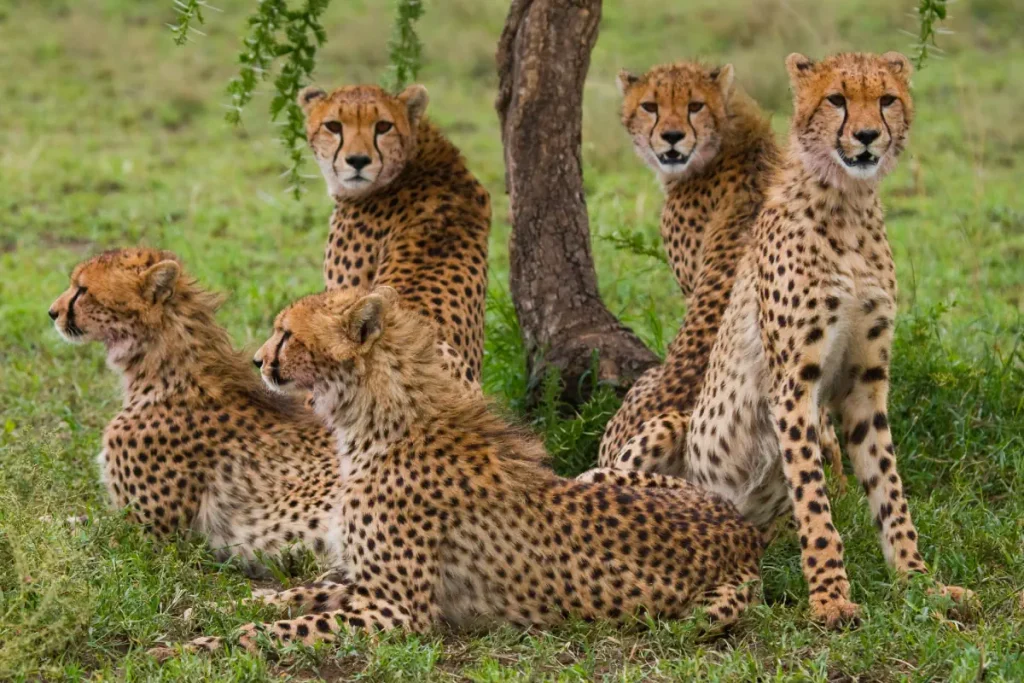
9. Cheetahs communicate with each other
Cheetahs communicate in many different ways. Some of these are through vocalizations such as purrs, bleats, barks, growls, hisses, and a high-pitched chirping sound.
The scent also plays a significant role in olfactory communication. Cheetahs often investigate urine-marked places (territories or common landmarks) for a long time by crouching on their forelegs and carefully smelling the place. Then the male will urinate there and sniff at its own scent before leaving.
Females may also show marking behavior but less prominently than males. Females in oestrus will show maximum urine marking, and their excrement can attract males from far off.
Social meetings are marked by mutual sniffing in oral and genital areas, grooming one another, rubbing the cheeks, and face-licking. Further physical contact has not been observed.
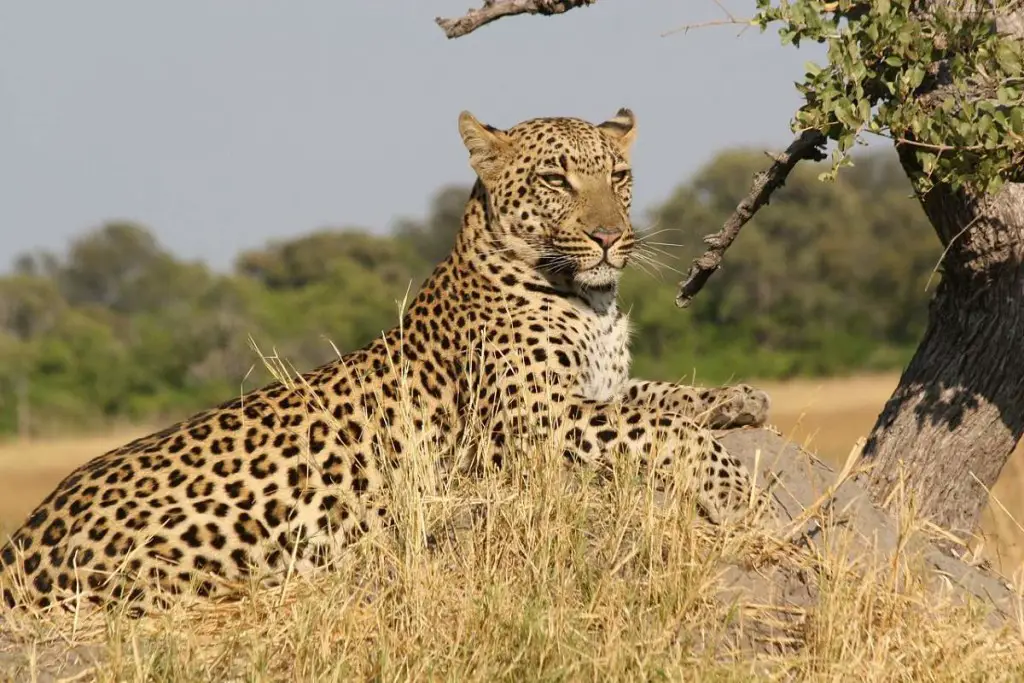
Related: 20 amazing leopard facts
10. The Life of a Cheetah
There are three stages in the lifecycle of the cheetah: a cub’s life, adolescence, and adult life.
The gestation period for the cheetah is 93 days and litters range in size from one or two up to six cubs (the occasional litter of eight cubs has been recorded, but it is rare).
At birth, the cubs weigh 8.5 to 15 ounces (240-420 grams) and are blind and helpless, like a house cat’s newborn kittens. Their mother will groom them patiently, purring quietly and providing them warmth and security.
After a day or so, the mother will leave the cubs to hunt for herself, so she can continue to care for the cubs. This is the most vulnerable time for the cubs, as they are left unprotected.
The cubs will live in a secluded nest for the next six to eight weeks, being regularly moved by their mother from nest to nest to avoid detection by predators. The mother will care for her cubs on her own for the next year and a half.
At about six weeks of age, the cubs begin following their mother on her daily travels as she is looking for prey. During these first few months, she cannot move far or fast and cub mortality is highest. Less than one in 10 will survive during this time, as they perish from predation by other large predators such as lions and hyenas, or from injuries. This is the time when life skills are taught.
Cheetah cubs have long tall hair that runs from their neck all the way down to the base of their tail, which is called the mantle. The mantle makes a cheetah cub look like a honey badger (which is very aggressive) and makes them blend into the tall grass, which helps keep them safe from threats like lions and hyenas. The mantle also keeps them warm.
Between four to six months of age, cheetah cubs are very active and playful. Trees provide good observation points and allow for the development of skills in balancing. Cubs’ semi-non-retractable claws are sharper at this age and help them grip the tall “play trees” they climb with their siblings.
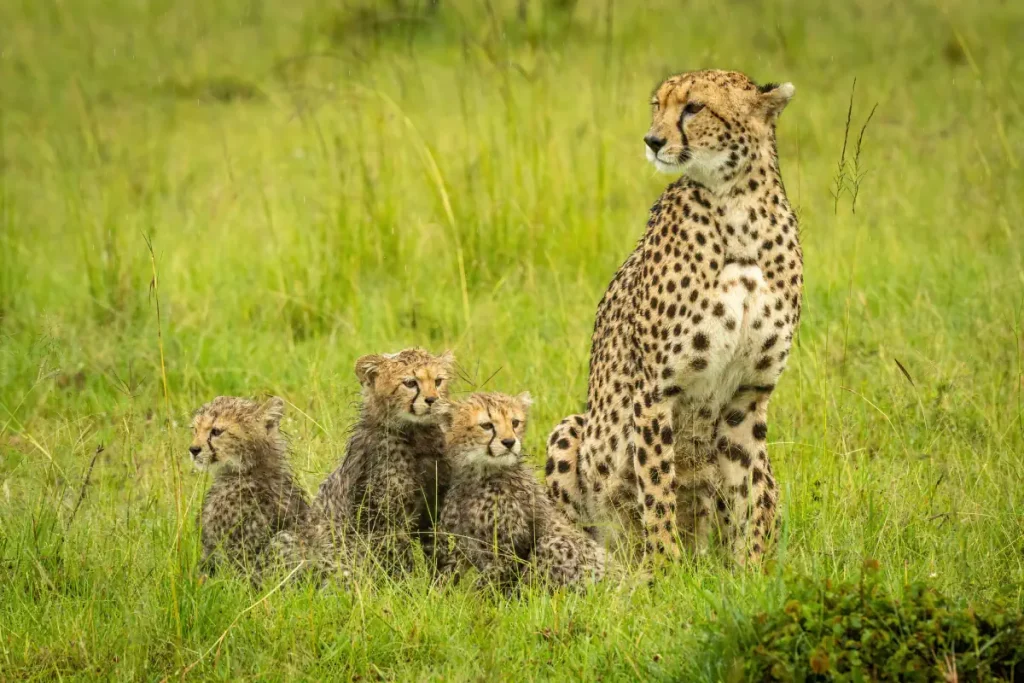
Learning to hunt is the most critical survival skill that the cubs will develop. At one year of age, cheetah cubs participate in hunts with their mother. The hunt has several components. It includes prey detection, stalking, the chase, tripping (or prey capture), and killing by means of a suffocation bite.
At about 18 months of age, the mother and cubs will finally separate. Although not fully adept at hunting on their own, independent male and female cubs will stick together for a few more months to master their hunting skills. When adolescent females begin cycling, dominant males will court them and drive their brothers away.
11. Cheetahs are specialized for hunt
Cheetahs are equipped with several special features that are crucial in successful and efficient hunting. Binocular vision is a very important asset since Cheetahs rely on sight to hunt as opposed to scent. The retinal fovea of the eye is of an elongated shape, giving a sharp wide-angle view. This aspect of the eye is also adapted for speed. The dark “tear marks” on the Cheetah’s face
The Cheetahs will perch upon a fallen tree or rocky ledge to scope out the surroundings and potential prey. The Cheetah is also a very vocal animal. With the ability to mimic the calls of some birds, by displaying a high-pitched chirping sound. When a bird falls for this deceiving call it will also fall prey to the sly Cheetah.
The Cheetah is the fastest land animal, reaching a top speed of 70 mph (112 km/h), but can only run for short sprints of up to 300 meters (985 feet). These sprints will usually last for 20 seconds, but rarely ever reach a full minute.
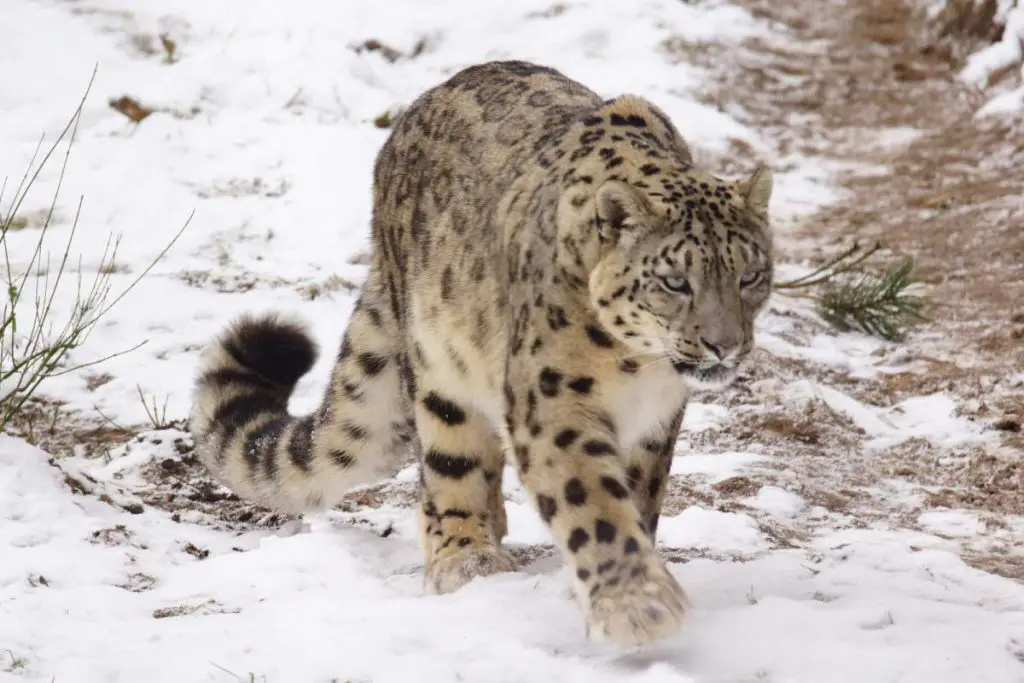
Related: 20 amazing snow leopard facts
12. They are one of the oldest cat species
The cheetah is one of the oldest of the big cat species, with ancestors that can be traced back more than five million years to the Miocene era.
13. A “genetic bottleneck” caused the low survival rate we see today
Relatives of the modern cheetah had worldwide distribution until about 20,000 years ago when the world’s environment underwent drastic changes in the Great Ice Age. Throughout North America, Europe, and Asia, about 75 percent of the mammal species vanished. Only a handful of the modern cheetah remained, having gone through a “genetic bottleneck” that resulted in inbreeding, which detrimentally impacts species survival.
The consequences of such a genetic bottleneck might include a low sperm count, decreased sperm motility, deformed flagella, difficulty in captive breeding, and susceptibility to disease.
14. They can be easily tamed
Unlike other big cats, the cheetah shows little aggression toward human beings and can be easily tamed, as it has been since antiquity. Reliefs in the Deir el-Bahari temple complex in Luxor tell of an expedition by Egyptians to the Land of Punt during the reign of the pharaoh Hatshepsut (1507-1458 BC) that fetched, among other things, animals called “panthers” for Egypt. Two types of “panthers” were depicted in these sculptures: leashed cheetahs, referred to as “panthers of the north”, and sturdy leopards, referred to as “panthers of the south”.
During the New Kingdom (16th to 11th centuries BC), cheetahs were common pet animals for royalty, who adorned the animals with ornate collars and leashes.
Hunting with cheetahs became more prevalent toward the seventh century AD. The 11th-century Clephane Horn, possibly of Byzantine origin, is believed to depict domesticated hunting cheetahs. In the Middle East, the cheetah would accompany the nobility to hunts in special seats behind saddles. Cheetahs continued to be associated with royalty and elegance in Western Asia until as late as the 19th century.

15. A cheetah’s spots and the ring pattern of its tail are unique
Like a human fingerprint, a cheetah’s spots and the ring pattern of its tail are unique. They have between 2,000 and 3,000 spots that cover nearly their entire body and may serve as camouflage by offsetting shadows in the gray-hued grasses they inhabit. Camouflage is not only essential for stalking prey but also for protecting cheetah cubs from predators.
16. They cannot taste sweet
Like all felines, cheetahs cannot taste sweet, and also they are hypercarnivores, which means they live exclusively on meat.
They hunt primarily smaller antelopes including springbok, steenbok, Thomson’s gazelle, impalas, and duiker. Cheetahs will also feed on wildebeest calves and, occasionally, smaller animals including rabbits, hares, and birds.
17. They don’t often drink water
Cheetahs have evolved to live in an environment where water is scarce and can survive on one drink every three to four days.
18. They are lazy
Despite being the fastest land animal on Earth, cheetahs actually spend most of their time doing nothing at all-almost 90 percent of their time. According to a 2014 study, cheetahs only spend about 12 percent of their day actually moving. The rest of the time is spent lazing around, conserving energy for those big bursts of speed.
19. Etymology of the Cheetah name
The vernacular name “cheetah” is derived from cītā (Hindi: चीता), which in turn comes from the Sanskrit word citrakāyaḥ (चित्रकायः) meaning “bright” or “variegated”.
The first recorded use of this word has been dated back to 1610.
An alternative name for the cheetah is “hunting leopard”.
The scientific name of the cheetah is Acinonyx jubatus. The generic name Acinonyx originated from the combination of two Greek words:
20. King Cheetahs exist!
First seen in 1926, and has been reported five more times in the wild, there’s an unusual-looking cheetah, the “king cheetah”, also known as Cooper’s Cheetah. It was once thought to be a separate sub-species. English zoologist Reginald Innes Pocock (4 March 1863 – 9 August 1947) described it as a new species by the name of Acinonyx rex (“rex” is Latin for “king”, the name translated to “king cheetah”).
But it is actually an African Cheetah exhibiting a rare fur pattern mutation. A recessive gene must be inherited from both parents in order for this “blotchy” pattern to appear. Hence, genetically the king cheetah is simply a variety of the common cheetah and not a separate species. This case is similar to that of the black panthers. The appearance is caused by the reinforcement of a recessive allele. As a result, if two mating cheetahs carry the mutated allele, then a quarter of their offspring can be expected to be king cheetahs.
This rare mutation causes cream-colored fur marked with large, blotchy spots and three dark, wide stripes extending from the neck to the tail.
Fortunately, today the magnificent king cheetah is on the increase, having been at the doors of extinction.
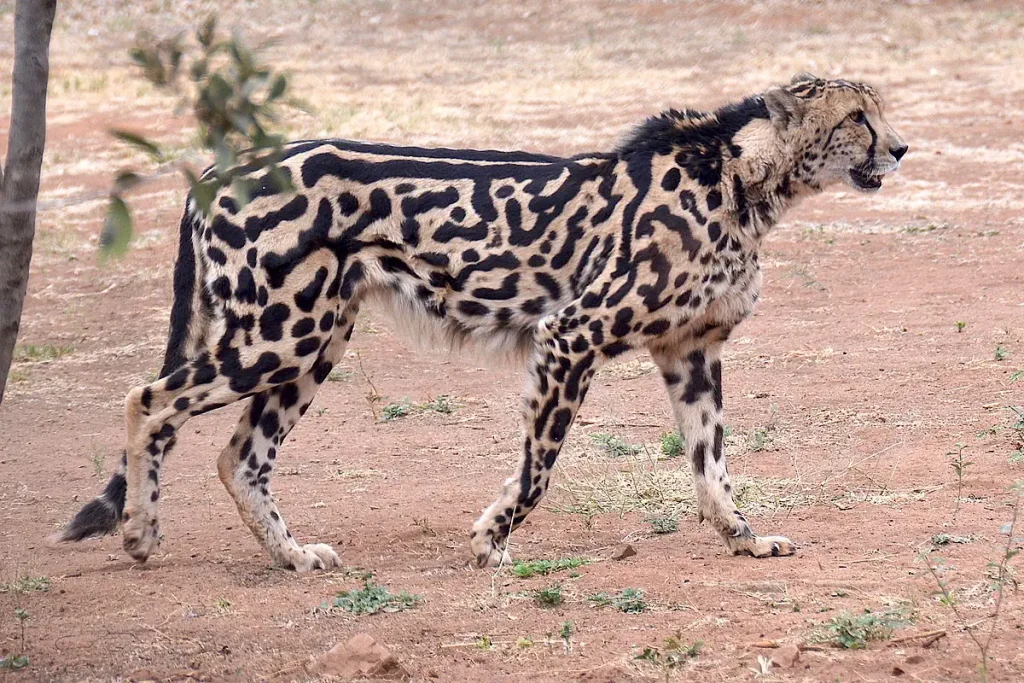
Some not-so-amazing cheetah facts
Once found throughout Asia and Africa, today Cheetah is IUCN Red Listed as vulnerable, as it suffered a substantial decline in its historic range in the 20th century due to habitat loss, poaching, illegal pet trade, and conflict with humans
By 2016, the global cheetah population has been estimated at approximately 7,100 individuals in the wild. making the cheetah Africa’s most endangered big cat. This number has dropped from 100,000 a century ago.
Most wild cheetahs exist in fragmented populations in pockets of Africa, occupying a mere 9% of their historic range. In Iran, less than 50 Asiatic cheetahs (sub-species) remain.
Remember, extinction is forever.
More than 75 percent of cheetahs in Africa live outside protected areas and on lands shared with rural farming communities. This causes conflicts with humans – which is really bad for the big cat.
Also, adult life for a cheetah is difficult. Cheetahs live fast and die young. There is competition between territorial males, which often results in death. The lifespan of an adult male is only 8 years.
They have a lot of enemies in the wild including lions, leopards, African wild dogs, and hyenas.
Adult mortality is one of the most significant limiting factors for cheetah population growth and survival.
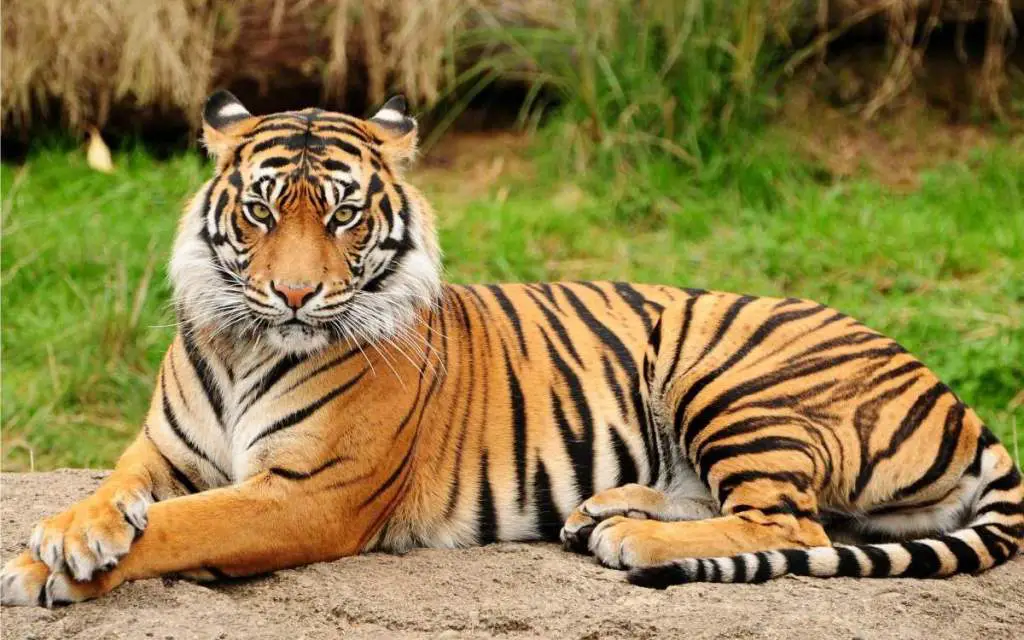
Related: 20 amazing tiger facts
Sources
- “Cheetah Facts for Kids” on the Cheetah Conservation Fund website
- Cheetah Fact Sheets on the Cheetah Conservation Fund website
- Cheetah facts on the Big Cat Rescue website
- Cheetah on Wikipedia
- “Our rare king cheetah” on wildmoz.com
- “Why Do Cheetahs Have Spots? And Other Cheetah Facts” on Smithsonian’s National Zoo and Conservation Biology Institute website
- Cheetah on One Kind Planet website
- 15 Fast Facts About Cheetahs on Mental Floss
- King Cheetah on Hoedspruit Endangered Species Center website
- “Cheetahs’ inner ear is one-of-a-kind, vital to high-speed hunting” on Phys.org
- “50 interesting cheetah facts that you never spotted before” on facts.net
- How Many Elephants are Left in the World in 2025? - August 17, 2025
- Moon Landings: All-Time List [1966-2025] - February 2, 2025
- What Is Max-Q and Why Is It Important During Rocket Launches? - January 16, 2025
